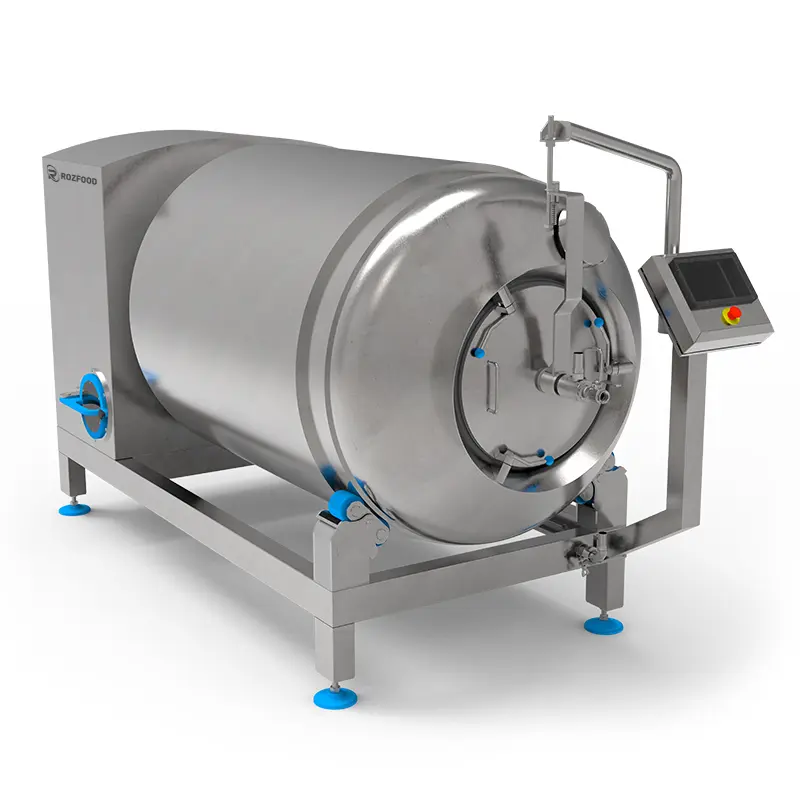Meat & Vacuum Tumblers: How to Choose the Right Machine (and Quote) for North American Plants

Every meat processor or sausage maker in Canada and the US knows that meat tumblers or vacuum tumblers are not just a “nice-to-have.” They are an essential tool that allows processors to achieve consistent texture, taste, and yield day in and day out. Vacuum models go even further: by continuously lowering the pressure, they accelerate the absorption of brine and marinade, increase water retention, and can improve tenderness. Results are clear to see and have been repeatedly confirmed in peer-reviewed studies, so why bother arguing? Almost everyone has one of these machines now, the only difference is what kind of vacuum tumbler you have.
Controlled tests have shown that vacuum tumbling increases the speed of marinating and improves tenderness and moisture retention compared to immersion in liquid, while reducing cooking losses and the amount of water released — precisely the indicators that plant managers monitor to determine emissions and product yield. Such tests have been conducted by various associations, institutes, organizations, and even equipment manufacturers - all of which have demonstrated the benefits of using tumblers.
Now let's look at the data from food quality control authorities in Canada and the US. They are responsible for ensuring compliance with regulatory requirements, including the operation of vacuum switches, which also affects food safety planning. FSIS stabilization/preparation guidelines define the thermal processing parameters for ready-to-eat products, and all mechanical/physical processes (including vacuum mixing) used to achieve the target values must be documented in the HACCP documentation. Compliance of equipment and standard operating procedures with these requirements simplifies auditing and speeds up the transition to new technology.
Let's take a look at the overall situation—the meat processing equipment market is growing steadily due to constant demand for certain types of products. It just so happens that right now, investments in North America are focused on making food production more automated, which boosts productivity and stability—and that's exactly what modern tumblers offer (programmable recipes, softer but stronger blades, improved pumps/valves, CIP-friendly frames).
Some information about the market volume. Analysts estimate the global equipment market to be approximately $11.9–13.4 billion in 2025, with continued growth, indicating that capacity expansion and modernization projects are not slowing down.
So when you request quotes for meat tumblers or more specific quotes for vacuum tumblers for meat for sausage, poultry or seafood, the smartest question to ask is not “Which machine is the cheapest?”
The right question is, “Which vacuum tumbler meets all my requirements—capacity, cycle time, power—at the lowest total cost per pound?”
Research and real-world performance data from factories show that increasing mixing time (and using vacuum) can significantly improve WHC and reduce the amount of liquid released; the right geometry and control system turn these lab results into real production performance.
What to include in your request for quotes (so that quotes are truly comparable)
When you request quotes for vacuum tumblers for meat in Canada and the US, gather and provide suppliers with enough information so that they can give you a realistic response:
- Products and formats: e.g., bone-in or boneless poultry, beef trimmings, dry sausage mixes, plant-based products.
- Batch size and cycle time: target batch weight in kg and number of cycles per shift; pilot or industrial batches.
- Marinade/brine properties: viscosity range, solids content, phosphates/phosphate-free, target salt content.
- Process objectives: marinade penetration percentage, WHC, tenderness/cutting quality, yield, and any subsequent processing steps related to the destruction of microorganisms.
- Hygiene regime: washing frequency, use of alkaline agents, CIP, or open cleaning.
By answering all these questions, you will gain a complete understanding of the price of vacuum stuffers (and avoid purchasing machines with insufficient capacity or blades that are too soft to provide the required level of absorption). Numerous tests have confirmed that vacuum, correct timing, and motion profile are factors that influence absorption and yield of the finished product.
KOMPO North America: what you get besides the numbers in the commercial offer
We supply European vacuum stuffers and classic meat stuffers to Canada and the USA. Our engineers will help you translate research results (absorption percentage, WHC, shear force) into specified parameters (vacuum level, rotation speed, holding time/intervals) that match your line specifications, not just laboratory conditions. We also have spare parts available and provide local service to maintain high equipment efficiency.
Typical results we aim for (and why they matter)
- Higher marinade absorption percentage / WHC → better juiciness, less waste during packaging.
- Increased tenderness → measurable reduction in shear force, consistent texture across all batches.
- Reduced cooking loss/water release → fewer cleaning complaints, cleaner labels.
And when you purchase vacuum stuffers from us, you get free technical support by phone or video link throughout the entire service life of the equipment.
Key features (most frequently requested by our customers)
Here, we describe the features and functions most frequently requested by our customers:
- Vacuum drums with durable seals and sanitary valves (USDA/CFIA compliant).
- Programmable recipes (vacuum level, rotation speed, interval/hold, reverse).
- Marinade circulation and built-in filtration for particle and viscosity control.
Open, easy-to-clean frame for faster sanitation; optional CIP kits.Batch sizes from pilot to industrial (ideal for ground meat producers for sausages and large multi-product plants).
Benefits (Why it pays back fast)
- Yield & quality gains (pickup↑, cook loss↓), validated in peer-reviewed studies.
- Shorter cycle times vs immersion; more throughput per shift.
- Labour savings via automated recipes and repeatability.
- Local stock in Canada & USA → rapid commissioning, no duties, spare parts on hand.
- Free expert support to dial in cycles and SOPs.
External research & guidance you can cite internally
- Comparative trials: vacuum tumbling vs immersion—pickup, tenderness, moisture retention gains.
- Reviews/meta-analyses on marination/tumbling and WHC, yield, texture.
- FSIS Appendix A/B process guidance relevant to thermal steps & stabilization in RTE workflows.
- Market context: steady growth in meat processing equipment investment.
